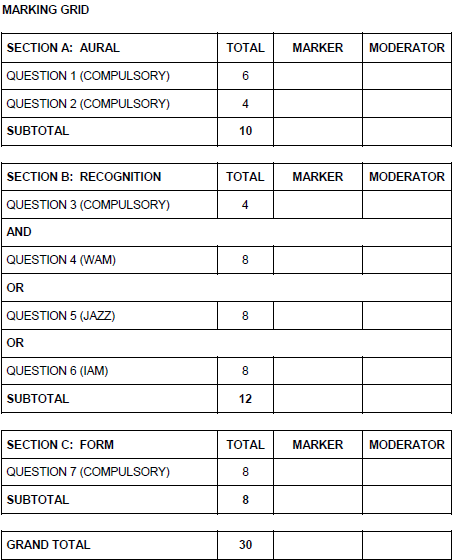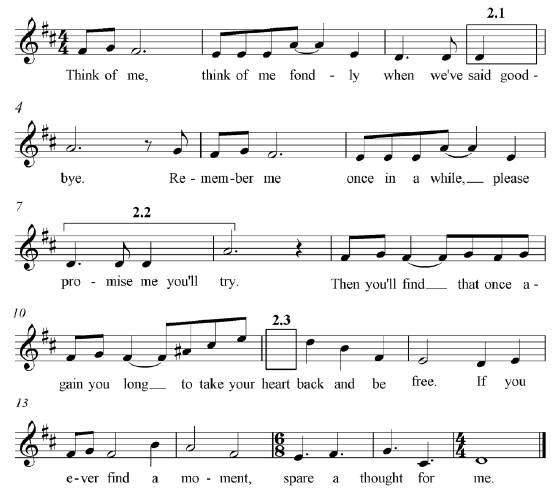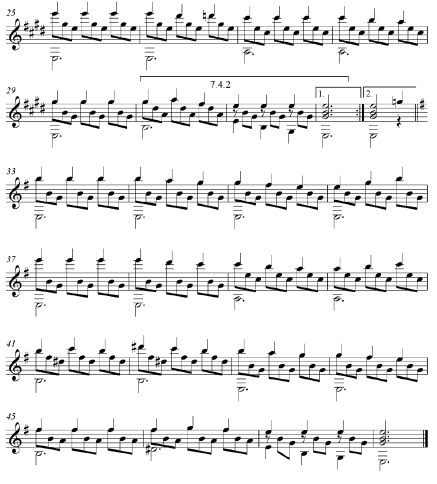MUSIC P2 Past Paper FEBRUARY/MARCH 2016 - GRADE 12 NATIONAL SENIOR CERTIFICATE
Share via Whatsapp Join our WhatsApp Group Join our Telegram GroupMUSIC P2
FEBRUARY/MARCH 2016
MARKS: 30
TIME: 1½ hours
INSTRUCTIONS AND INFORMATION
- This question paper consists of THREE sections:
SECTION A (Aural) (10)
SECTION B (Recognition) (12)
SECTION C (Form) (8) - QUESTION 1, QUESTION 2, QUESTION 3 and QUESTION 7 are compulsory.
- Answer QUESTION 4 (Western Art Music (WAM)) OR QUESTION 5 (JAZZ) OR QUESTION 6 (Indigenous African Music (IAM)).
- Write all your answers on this question paper. Use a pencil for music notation and blue or black ink for the other answers.
- This examination will be written while candidates are listening to a CD.
- The music teacher of the centre must conduct the examination in the presence of the invigilator.
- The last page of this question paper is manuscript paper intended for rough work. Candidates may remove this page.
- Candidates may NOT have access to any musical instrument for the duration of this examination.
- Write neatly and legibly.
INSTRUCTIONS TO THE PERSON OPERATING THE SOUND EQUIPMENT
|
SECTION A: AURAL
QUESTION 1
| Play Track 1 TWICE in succession. |
1.1
Listen to the melodic and rhythmic phrase. Notate the rhythm of the missing notes in bars 3–41 below. (3)
| Play Track 1 TWICE again. Pause for 30 seconds in between. |
| Play Track 2 TWICE in succession. |
1.2
Listen to the extract from Menuet in G by Mozart. Fill in the missing pitches that correspond with the music that you hear on the given score.
| Play Track 2 ONCE more. |
(3)
[6]
QUESTION 2
| Play Track 3 ONCE to provide a general overview. |
Listen to the extract from Think of Me (Phantom of the Opera) while you follow the vocal score. Answer the questions that follow.
| Play Track 4 TWICE. |
2.1 Name the interval at 2.1 (in the vocal part) in bar 3, e.g. Major 2nd.
(1)
| Play Track 5 TWICE. |
2.2 Name the cadence at 2.2 in bars 7 and 8. (1)
| Play Track 6 TWICE. |
2.3
This extract starts in bar 9. At 2.3 in bar 11 you will hear a non-chordal note in the vocal line.
2.3.1 Notate this note on the score. (1)
2.3.2 Name the type of non-chordal note. (1)
[4]
TOTAL SECTION A: 10
SECTION B: RECOGNITION OF MUSIC CONCEPTS
QUESTION 3: GENERAL LISTENING (COMPULSORY)
Study the items in COLUMN A in QUESTION 3.1–3.4 for two minutes.
| Play Track 7 TWICE. |
3.1
Mark TWO items in COLUMN A that relate to Track 7. Make a cross (X) in TWO appropriate blocks.
| COLUMN A | Track 7 |
| Ragtime | |
| Idiophone | |
| Trombone | |
| Cyclic chord structure | |
| Trumpet | |
| Pentatonic |
(2)
| Play Track 8 TWICE. |
3.2
Mark TWO items in COLUMN A that relate to Track 8. Make a cross (X) in TWO appropriate blocks.
| COLUMN A | Track 8 |
| Anacrusis | |
| Allegro | |
| Homophonic | |
| Accelerando | |
| Polyphonic | |
| Pizzicato |
(2)
| Play Track 9 TWICE. |
3.3
Mark TWO items in COLUMN A that relate to Track 9. Make a cross (X) in TWO appropriate blocks.
| COLUMN A | Track 9 |
| Alto | |
| Aerophone | |
| Ostinato | |
| American Jazz | |
| Idiophone | |
| Synthesiser |
(2)
| Play Track 10 TWICE. |
3.4
Mark TWO items in COLUMN A that relate to Track 10. Make a cross (X) in TWO appropriate blocks.
| COLUMN A | Track 10 |
| Chorus | |
| Polyphonic | |
| Alla marcia | |
| Pedal point | |
| Big Band | |
| Tranquillo |
(2)
(8 ÷ 2) [4]
Answer QUESTION 4 (WAM) OR QUESTION 5 (JAZZ) OR QUESTION 6 (IAM).
QUESTION 4: WAM
4.1
Listen to the extracts and answer the questions that follow.
| Play Track 11 ONCE. |
4.1.1
Identify the composer and title of this work.
Composer: _____________________________
Title: _____________________________ (2)
| Play Track 12 TWICE. |
4.1.2
Which melodic compositional technique is heard in the violas and bassoons at the beginning of this extract? (1)
| Play Track 13 TWICE. |
4.1.3
Which ONE of the following terms best describes the melodic material of the strings and flutes in this extract? Make a cross (X) in the appropriate block.
| Cantabile | Arpeggios | Chromatic | Diatonic |
(1)
| Play Track 14 TWICE. |
4.1.4
Give a suitable Italian term to describe the dynamic level of the melodic line in this extract. (1)
4.2 Listen to the extracts and answer the questions that follow.
| Play Track 15 ONCE. |
4.2.1 Identify the genre of this music. (1)
4.2.2 Name the characters who sing in this extract. (2)
| Play Track 16 ONCE. |
4.2.3 Write down a suitable Italian term to describe the change of tempo towards the end of this extract. (1)
| Play Track 17 ONCE. |
4.2.4
Choose the word that best describes the articulation applied in the accompaniment of this extract. Make a cross (X) in the appropriate block.
| Staccato | Leggiero | Pizzicato | Vivace |
(1)
4.3
Listen to TWO extracts from Beethoven's Symphony No. 6 which will be played twice each and answer the questions.
| Play Track 18 TWICE. |
4.3.1
This extract begins with a solo woodwind instrument which is followed by a solo brass instrument. Name each of these instruments.
Woodwind instrument: ________________________________
Brass instrument: _________________________________ (2)
4.3.2
Identify the movement from which this extract is taken. (1)
| Play Track 19 TWICE. |
4.3.3 Identify the movement from which this extract is taken. (1)
| Play Track 20 TWICE. |
4.3.4
Choose the time signature of this extract. Make a cross (X) in the appropriate block. (1)
4.3.5
Mark the character or mood of this extract in COLUMN A. Make a cross (X) in the appropriate block.
| COLUMN A | Track 20 |
| Lento | |
| Tranquillo | |
| Agitato | |
| Maestoso | x |
Answer:
Maestoso
| Maestoso = 1 mark |
(1)
(16 ÷ 2) [8]
TOTAL SECTION B: 12
OR
QUESTION 5: JAZZ
5.1 Listen to the extracts and answer the questions that follow.
| Play Track 21 ONCE. |
5.1.1
With which ONE of the following terms would you associate this extract? Make a cross (X) in the appropriate block.
| Marabi | Mbaqanga | Jazz in exile |
(1)
5.1.2 Write down the title of this work. (1)
5.1.3 Name TWO artists associated with this extract.(2)
| Play Track 22 TWICE. |
5.1.4 A repetitive rhythmic drive is heard in this extract. Which instrument(s) are heard in this regard? Make a cross (X) in the appropriate block.
| Instrument(s) | Track 22 |
| Horn section, bass and piano | |
| Cymbals, bass and piano | |
| Piano only |
(1)
5.2 Listen to the extracts and answer the questions that follow.
| Play Track 23 ONCE. |
5.2.1 Identify the South African jazz style. (1)
5.2.2 Give TWO reasons for your answer to QUESTION 5.2.1. (2)
5.2.3 Name ONE artist associated with this extract. (1)
5.2.4 Name the title of the work. (1)
5.3 Listen to the extracts and answer the questions that follow.
| Play Track 24 ONCE. |
5.3.1 Identify the South African jazz style. (1)
5.3.2 Give TWO reasons for your answer to QUESTION 5.3.1. (2)
5.3.3 Name the female vocalist associated with this extract. (1)
| Play Track 25 ONCE. |
5.3.4 Describe how the call-and-response technique is used in this extract. (1)
| Play Track 26 ONCE. |
5.3.5
With which of the following items do you associate this extract? Make a cross (X) in the appropriate block.
| Riff | Electric organ | Polyphonic |
(1)
(16 ÷ 2) [8]
TOTAL SECTION B:
OR
QUESTION 6: IAM
6.1 Listen to the extracts and answer the questions that follow.
| Play Track 27 ONCE. |
6.1.1 Identify the South African style. Make a cross (X) in the appropriate block.
| Marabi | Mbaqanga | Isicathamiya |
(1)
6.1.2 Give TWO reasons for your answer to QUESTION 6.1.1. (2)
| Play Track 28 ONCE. |
6.1.3 Name the artist/group with whom you associate this song. (1)
6.2 Listen to the extracts and answer the questions that follow.
| Play Track 29 ONCE. |
6.2.1 With which type of song do you associate the extract? Make a cross (X) in the appropriate block.
| Wedding song | Funeral song | Struggle song | War song |
(1)
| Play Track 30 ONCE. |
6.2.2 With which type of song do you associate the extract? Make a cross (X) in the appropriate block.
| Lullaby | Celebration song | Initiation song | Work song |
(1)
| Play Tracks 31 and 32 TWICE in succession. |
6.2.3 Listen to the TWO tracks which will be played TWICE in succession.
Complete the table below. Identify the voice type, compositional technique and percussion instrument used in each track.
| Track 31 | Track 32 | |
| Voice type | ||
| Compositional technique | ||
| Percussion instrument |
(3)
6.3 Listen to the extracts and answer the questions that follow.
| Play Track 33 ONCE. |
6.3.1 Identify the chordophone that you hear in the introduction of this extract. (1)
6.3.2 Name the voice type of the solo singer who introduces the melody. (1)
6.3.3
Identify the vocal compositional technique used in this extract. Make a cross (X) in the appropriate block.
| Call and response | Ululation | Crepitation | Imitation |
(1)
6.4 Listen to the extracts and answer the questions that follow.
| Play Track 34 and Track 35 TWICE in succession. |
Identify TWO instruments in each of the extracts.
| Track 34 | Track 35 | |
| Instruments |
(4)
(16 ÷ 2)[8]
TOTAL SECTION D:12
SECTION C: FORM
QUESTION 7
Read and study the questions for ONE minute.
| Play Track 36 ONCE to provide an overview. |
Listen to the following piece while you study the score.
7.1 Name the overall form of this work. (1)
7.2
Motivate your answer to QUESTION 7.1 by indicating the main sections on the score. Write capital letters above the staff. (3)
7.3 Name the main key of the work in bars 1–16. (1)
7.4 To which key does the work modulate (change key) in bar 17? (1)
| Play Track 37 ONCE. |
7.5 Which compositional technique is used in the bass part from in 1–5? (1)
| Play Track 38 ONCE. |
7.6 This track starts in bar 27. Name the cadence in bars 30–32. (1)
| Play Track 39 ONCE. |
[8]
TOTAL SECTION C: 8
GRAND TOTAL: 30




